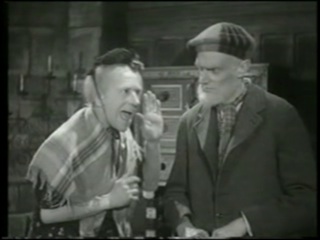So, along the way, during my progress in life, I seem to have acquired a box set of Will Hay films, a bigger box set of Norman Wisdom films, Arthur Askey’s THE GHOST TRAIN, and an extensive collection of George Formby bootlegs. One disc seems to have six hours of George on it, a heartbreaking thought.
I’m not going to watch all those, am I? Masochism has limits. But maybe I can blog about the odd sample. Of course it would be wrong to exclude Arthur Lucan (Old Mother Riley) and I’ve never seen a Charlie Drake movie, although I have seen him do some “straight” acting. Who else? I like some of the Carry On films and don’t consider those actors awful, but the later entries in the series are plenty gruesome, and the “sexy” knock-offs — Confessions of… etc are incredibly terrible. If a requirement of an awful British comedian is a ghastly face, maybe Robin Askwith counts. But I don’t really dislike him as a performer. It’s the things he tended to perform in that give me the dry heaves. I don’t know that I’m going to watch any of those — I take the conspiratorial view that the saucy British sex comedy was part of a government programme, Operation Prole-Wipe, aimed at reducing reproduction among the working classes. One glance at Askwith’s encrimsoned features in the act of love is enough to ensure a month’s uninterrupted sterility — it’s an unshakeable article of faith with me.





Is Tommy Steele a comedian, as such? He’s definitely awful. And he fits in with most of these others, in that I have a sneaking affection for him. Part of being British is having a sneaking affection for really indefensible tripe, including actual literal tripe. Formby and Wisdom and Steele were on TV a lot when I was a kid, and I enjoyed their singing, mugging and falling over. On the other hand, Frankie Howerd was a comedian of minor genius, but his films are generally awful. I’m in two minds with Frankie.
Maybe we should work out some ground rules. A true awful British comedian should, in Matthew Sweet’s memorable phrase, “like a human being reflected in a tap.” Yes, he was speaking of George. The best A.B.C.’s tend to be northerners, but that’s more of a guideline. Most of the fellows I’m thinking of are from the 1930s, 40s and 50s, but I think the trend continues, in attenuated form, at least as late as Cannon & Ball in Val Guest’s BOYS IN BLUE (1983) and Roy “Chubby” Brown in U.F.O. Most of them are aimed at working class audiences, often working class children, and many of them are working class themselves, but not all (stand up, Jack Hulbert).
Along the way, I’ll be checking out comics I’m barely familiar with, like the Crazy Gang. I might find some who aren’t so awful after all. I’ll write about them anyway. This will lead me into consideration of neglected filmmakers like Val Guest and Marcel Varnel. And I’ll take suggestions, starting now! Also interested in impassioned defences of your favourite A.B.C.s. I realise some of them do have fans.



















